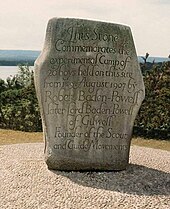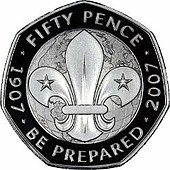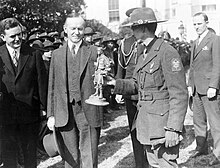Scouting
It is a program of informal education with an emphasis on practical outdoor activities, including camping, woodcraft, aquatics, hiking, backpacking, and sports.Another widely recognized movement characteristic is the Scout uniform, by intent hiding all differences of social standing in a country and encouraging equality, with neckerchief and campaign hat or comparable headwear.[4] In 1896, Baden-Powell was assigned to the Matabeleland region in Southern Rhodesia (now Zimbabwe) as Chief of Staff to Gen. Frederick Carrington during the Second Matabele War.In June 1896 he met here and began a lifelong friendship with Frederick Russell Burnham, the American-born Chief of Scouts for the British Army in Africa.[5][6] This was a formative experience for Baden-Powell not only because he had the time of his life commanding reconnaissance missions into enemy territory, but because many of his later Boy Scout ideas originated here.[10] During this time in the Matobo Hills Baden-Powell first started to wear his signature campaign hat[11] like the one worn by Burnham, and acquired his kudu horn, the Ndebele war instrument he later used every morning at Brownsea Island to wake the first Boy Scouts and to call them together in training courses.[15] The Mafeking Cadet Corps was a group of youths that supported the troops by carrying messages, which freed the men for military duties and kept the boys occupied during the long siege.[19] The siege of Mafeking was the first time since his own childhood that Baden-Powell, a regular serving soldier, had come into the same orbit as "civilians"—women and children—and discovered for himself the usefulness of well-trained boys.In the United Kingdom, the public, through newspapers, followed Baden-Powell's struggle to hold Mafeking, and when the siege was broken he had become a national hero.[23] Seton, a British-born Canadian-American living in the United States, met Baden-Powell in October 1906, and they shared ideas about youth training programs.[27] In late 1907, Baden-Powell went on an extensive speaking tour arranged by his publisher, Arthur Pearson, to promote his forthcoming book, Scouting for Boys.He had not simply rewritten his Aids to Scouting; he omitted the military aspects and transferred the techniques (mainly survival skills) to non-military heroes: backwoodsmen, explorers (and later on, sailors and airmen).[25] At the beginning of 1908, Baden-Powell published Scouting for Boys in six fortnightly parts, setting out activities and programmes which existing youth organisations could use.[33] However, because of the popularity of his person and the adventurous outdoor games he wrote about, boys spontaneously formed Scout patrols and flooded Baden-Powell with requests for assistance.By 1908, Scouting was established in Gibraltar, Malta, Canada, Australia, New Zealand, Malaya (YMCA Experimental Troop in Penang) and South Africa.By 1910, Argentina, Denmark, Finland, France, Germany, Greece, India, Mexico, the Netherlands, Norway, Russia, Sweden, and the United States had Boy Scouts.He was a 50-year-old retired army general when he founded Scouting, and his revolutionary ideas inspired thousands of young people, from all parts of society, to get involved in activities that most had never contemplated.Comparable organizations in the English-speaking world are the Boys' Brigade and the non-militaristic Woodcraft Folk; however, they never matched the development and growth of Scouting.This includes not only its selection of animal badges for Cub Scouts, but the underlying assumption that American native peoples are more closely connected with nature and therefore have special wilderness survival skills which can be used as part of the training program.WOSM describes Scouting as "a voluntary nonpolitical educational movement for young people open to all without distinction of origin, race or creed, in accordance with the purpose, principles and method conceived by the Founder".[56] It is the goal of Scouting "to contribute to the development of young people in achieving their full physical, intellectual, social and spiritual potentials as individuals, as responsible citizens and as members of their local, national and international communities.These experiences, along with an emphasis on trustworthiness and personal honor, help to develop responsibility, character, self-reliance, self-confidence, reliability, and readiness; which eventually lead to collaboration and leadership.The form of the promise and laws have varied slightly by country and over time, but must fulfil the requirements of the WOSM to qualify a National Scout Association for membership.[67] Various initiatives are in train towards achieving this aim including the development of activities that benefit the wider community, challenge prejudice and encourage tolerance of diversity.The leather straps and toggles of the campaign hats or Leaders' Wood Badges could be used as emergency tourniquets, or anywhere that string was needed in a hurry.In 1934, Scouters requested a change to the design because of the connection of the swastika with its more recent use by the German National Socialist Workers (Nazi) Party.[72] Scouting and Guiding movements are generally divided into sections by age or school grade, allowing activities to be tailored to the maturity of the group's members.[81] Above the unit are further uniformed positions, called Commissioners, at levels such as district, county, council or province, depending on the structure of the national organization.They believe that Scouting in general has moved away from its original intent because of political machinations that happen to longstanding organizations, and want to return to the earliest, simplest methods.[116] The works of painters Ernest Stafford Carlos, Norman Rockwell, Pierre Joubert and Joseph Csatari and the 1966 film Follow Me, Boys!















Scout (disambiguation)Brownsea IslandDorsetRobert Baden-Powell, 1st Baron Baden-Powellsocial movementScout methodinformal educationoutdoor activitiescampingwoodcraftaquaticshikingbackpackingsportsuniformhiding all differences of social standingequalityneckerchiefcampaign hatheadwearinsigniafleur-de-listrefoilmerit badgesRobert Baden-Powelllieutenant generalBritish ArmyScouting encampmentEnglandScouting for BoysWolf CubsRoversGirl GuidesUnited KingdomBrownie GuideGirl Guide and Girl ScoutRanger GuideWorld Organization of the Scout MovementWorld Association of Girl Guides and Girl ScoutsWorld Federation of Independent ScoutsWorld Organization of Independent ScoutsOrder of World ScoutsInternational Union of Guides and Scouts of EuropeConfederation of European Scoutsfirst experimental Scout campCharterhousepublic schoolsBritish Indiamilitary scoutingMatabelelandSouthern RhodesiaFrederick CarringtonSecond Matabele WarFrederick Russell BurnhamMatobo HillsfrontiersmenAmerican Old Westindigenous peoples of the AmericasscoutcrafttrackingfieldcraftNdebeleSouth AfricaSecond Boer Warbesieged in the small town of Mafikeng (Mafeking)Mafeking Cadet Corpscompassspearheadnational heroBoys' Brigadeyouth movementBritish fifty pence coinErnest Thompson SetonParkstoneHamworthyBournemouthWintonPoole HarbourArthur Pearsonsurvival skillsFourstonesHumshaughCrystal PalaceThe Boy Scouts AssociationThe Girl GuidesWilliam A. SmithSea ScoutsAir ScoutsScout LawScout promiseGirl Guiding/ScoutingOlave Baden-PowellBritish EmpireGibraltarCanadaAustraliaNew ZealandMalayathe Crystal PalaceFinlandGermanyGreeceCub ScoutRover Scoutnational celebrationsAgnes Baden-PowellCrystal Palace RallyBrowniesFirst World JamboreeGrand HowlScoutmasterYorkshireWood BadgeWorld War IGilwell ParkThe Scout AssociationcampsiteAids to ScoutmastershipScouting LeadersCalvin CoolidgeWoodcraft FolkmilitaristicScouts' OwnfrontierAmerican native peoplesRudyard Kipling

